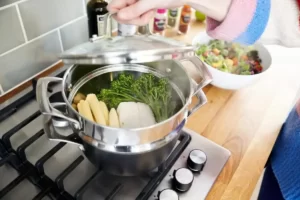Cacio e pepe sounds like it should be easy. It’s just pasta, cheese, and pepper. But making it the right way? That takes a little more focus than you might think.
The sauce shouldn’t be stringy or oily. It shouldn’t have chunks of cheese or clumps of pepper.
What you want is a smooth, glossy coating that sticks to the pasta like it belongs there. And the only way to get that is by using the right technique—no shortcuts, no guessing.
You don’t need cream, butter, or olive oil. Just Pecorino Romano, black pepper, and starchy pasta water. That’s it. But every part matters.
How fine the cheese is grated. How hot the water is when it hits the cheese. How much you toss. This recipe covers all of that.
Done right, the pasta will be creamy without any cream, and bold without being heavy. And once you nail it, it’s hard to stop making it.
Table of Contents
ToggleWhat Is Cacio E Pepe Pasta?
Cacio e pepe is a traditional Roman pasta dish made with just three ingredients: Pecorino Romano cheese, black pepper, and pasta. The name means “cheese and pepper” in Italian.
It may look simple, but getting the sauce smooth and creamy takes good technique. The dish doesn’t use any cream, butter, or oil—only the starch from pasta water helps bind the cheese and pepper into a silky sauce.
It’s bold, peppery, salty, and completely relies on the quality of the cheese, the right kind of pepper, and how well you toss the pasta with the sauce. Cacio e pepe is all about doing a few things really well.
Authentic Cacio e Pepe Recipe
Ingredients
- 200g dried spaghetti (or tonnarelli, if available)
- 90g Pecorino Romano cheese, finely grated
- 1 tsp freshly cracked black pepper (plus more to finish)
- 1 tsp kosher salt (for the pasta water)
- 3 tbsp starchy pasta water (reserved during cooking)
Important prep tip: Use a microplane or the finest side of a box grater to grate your cheese. It should look fluffy and almost powdery—this is key to creating a smooth sauce with no clumps.
Instructions
- Bring a large pot of water to a boil. Add just 1 tsp of salt—less than usual, because Pecorino is already very salty.
- Drop in the spaghetti and stir once or twice to prevent sticking. Cook until just shy of al dente (about 1 minute less than package instructions).
- While the pasta cooks, heat a wide, dry pan over medium-low and add the freshly cracked black pepper. Toast it gently for about 45 seconds, until fragrant—not burnt. Remove from heat.
- Scoop out 3/4 cup of pasta water into a measuring cup before draining. Set aside.
- In a mixing bowl (not the pan), place the grated Pecorino Romano and a generous pinch of the toasted pepper.
- Slowly drizzle in 3 tablespoons of hot pasta water, whisking continuously to form a thick, smooth cheese paste. It should resemble a loose ricotta or creamy spread—not runny.
- Transfer the drained pasta to the dry pan you used for toasting the pepper (don’t turn the heat on yet). Add the cheese paste directly to the pasta.
- Now add 1 to 2 more tablespoons of hot pasta water, and toss vigorously with tongs for a full 1–2 minutes. Let the residual heat melt the cheese and emulsify the sauce. If it’s too tight, add another splash of water and keep tossing until glossy and perfectly coating each strand.
- Serve immediately in warm bowls. Finish with a final dusting of cracked black pepper and a whisper of extra Pecorino if desired.

Tips For Making The Best Cacio E Pepe
Even though it’s only a few ingredients, these tips will help you avoid clumps and get that perfect creamy texture:
- Use finely grated Pecorino Romano: The cheese should be fluffy, not chunky. A microplane grater works best.
- Toast the pepper: Lightly toast black pepper in a dry pan until it smells strong and sharp. This brings out the flavor.
- Don’t use too much salt in the pasta water: Pecorino is salty on its own, so go easy on the salt when boiling the pasta.
- Save the pasta water: This starchy water is what helps melt the cheese and form the sauce.
- Add hot water slowly to the cheese: Pour a little at a time and stir constantly to make a smooth paste before mixing it with the pasta.
- Toss the pasta well: Use tongs to toss quickly and evenly. This helps emulsify the sauce and keeps it from clumping.
What Type Of Pecorino Is Best For Cacio E Pepe?
Pecorino Romano is the only cheese traditionally used for cacio e pepe. It’s sharp, salty, and aged long enough to give the sauce that signature flavor. But not all Pecorino is the same.
- Choose DOP Pecorino Romano: This label means it’s made using traditional methods in specific Italian regions.
- Avoid softer pecorinos: Some are meant for eating plain, not for melting. Look for hard, dry blocks that grate easily.
- Buy whole blocks and grate yourself: Pre-grated cheese often has added starches that stop it from melting properly.
How To Identify Real Pecorino Romano?
You can easily spot real Pecorino Romano if you know what to look for:
- Look for the DOP stamp: It’s usually printed on the rind and means the cheese was made under strict standards in Italy.
- Check the rind for black coating: Traditional Pecorino Romano often has a black wax rind, especially from Lazio.
- Feel the texture: It should be dry, firm, and crumbly—not soft or rubbery.
- Smell and taste: It should be sharp, salty, and a little tangy—not mild or creamy like Parmesan.
What To Serve With Cacio E Pepe?
Here are a few dishes that pair well with cacio e pepe:
- Roasted artichokes
- Grilled asparagus
- Caprese salad
- Sautéed spinach
- Crusty sourdough bread
- Roasted chicken
- Marinated olives
- Prosciutto with melon
How To Store Cacio E Pepe?
Cacio e pepe is best eaten fresh, but if you need to store leftovers, here’s how to keep it from drying out too much:
- Cool completely before storing: Let the pasta come to room temperature first so condensation doesn’t build up.
- Use an airtight container: This keeps the pasta from hardening or absorbing other fridge smells.
- Refrigerate for up to 2 days: It’s safe to eat for a couple of days, but the texture will change.
- Reheat gently: Add a splash of water and reheat slowly in a pan, stirring often to bring back the creamy texture.
Variations Of Cacio E Pepe
While the classic version uses just cheese, black pepper, and pasta, there are a few creative ways to switch it up while still keeping the dish true to its roots.
- Use bucatini or rigatoni instead of spaghetti: These shapes hold sauce differently and give the dish a new texture without changing the flavor.
- Try a mix of cheeses: You can combine Pecorino Romano with a small amount of Parmesan for a slightly milder flavor. Just make sure both melt well.
- Add crushed red pepper: For a spicier twist, a pinch of crushed red pepper flakes can bring more heat.
- Use whole peppercorns, freshly cracked: This brings out more depth than pre-ground pepper and adds a bit of texture.
- Add lemon zest: A tiny amount gives it a bright, citrusy layer without making it taste like a different dish.
How To Get The Creamy Sauce (Cremina)?
The creamy sauce in cacio e pepe is all about technique, not cream. This thick, glossy coating is called cremina, and here’s how to get it right:
- Grate the cheese very fine: It should look fluffy and soft, not chunky. This helps it melt smoothly.
- Use very hot pasta water: The heat helps melt the cheese, and the starch helps it stick to the pasta.
- Make a cheese paste first: Mix the grated cheese with a small amount of hot water in a bowl before it touches the pasta. Stir it into a thick, smooth paste.
- Toss everything quickly: Once you mix the pasta with the cheese paste, toss fast and continuously. This movement builds the emulsion and turns it into that creamy coating.
Why Does Cacio E Pepe Sauce Clump?
If the cheese clumps, it usually means the heat or water wasn’t handled properly. Here’s what to watch out for:
- Water was too hot or not hot enough: Boiling water can cook the cheese too fast. Lukewarm water won’t melt it at all. Use water that’s hot but not boiling.
- Cheese was added straight to hot pasta: If the cheese touches the hot pan or pasta without water, it melts unevenly and sticks.
- Cheese wasn’t grated fine enough: Larger chunks melt unevenly and cause clumps.
- You didn’t toss or stir fast enough: Tossing helps build the sauce. Letting it sit still allows the cheese to stick and clump.

Can You Make Cacio E Pepe Ahead Of Time?
It’s not the best dish to make ahead because the sauce starts to firm up as it cools. But if you really need to prepare it early, here’s what you can do:
- Cook the pasta and prep the cheese paste separately: Keep them apart until you’re ready to serve.
- Store them both in airtight containers: Put the pasta in one container and the cheese mixture in another.
- Reheat gently with a splash of water: When you’re ready, combine everything in a pan with a bit of fresh hot water and toss well to bring the sauce back.
How To Keep Cheese From Clumping In Cacio E Pepe?
Getting a smooth, creamy sauce without clumps depends on a few simple steps. These tips will help every time:
- Use very finely grated cheese: This makes it easier to melt and mix.
- Add hot water to the cheese first, not the pasta: This helps it melt gently and turn into a sauce.
- Mix the cheese into a paste before adding pasta: A smooth paste blends better and reduces the chance of lumps.
- Toss constantly: Don’t just stir slowly—really toss the pasta with tongs to keep the sauce moving and stop the cheese from sticking in one spot.
- Avoid high heat: Too much heat causes the cheese to seize and separate instead of melting evenly.
You May Also Like To Check Out These Recipes
- Oven Baked Sweet Potato Chips
- Viral Tiktok Cucumber Salad
- Funeral Potatoes With Hashbrowns
- Chinese Special Fried Rice Restaurant Style
- Authentic Spanish Seafood Paella
- Homemade Pretzel Crust Pizza
- Tomato Pasta
- Cheese Danish
- Baked Chicken Nuggets
- Spring Rolls
- Chicken Egg Rolls
- Creamy Cherry Tomato Pasta
- 5 Ingredient Orange Chicken
- Egg Roll In A Bowl
- Chicken Biryani
- Creamy Mushroom Pasta
- Cucumber Sandwiches
- Chicken Korma
- Grilled Fish Tacos With Cabbage Slaw
- Best Indian Mango Chicken Curry
- Authentic Thai Red Curry Shrimp
- Traditional Banh Mi
- Sesame Crusted Tuna Steaks With Ginger-Soy Sauce











